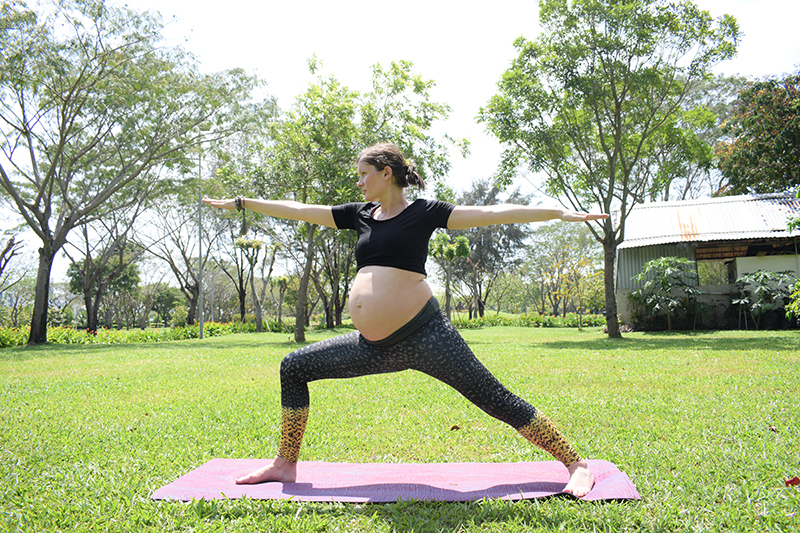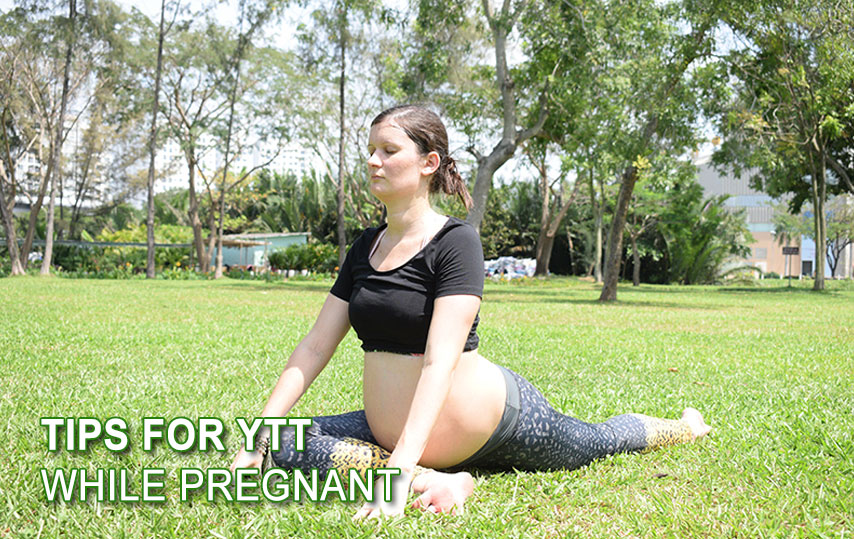I just completed my four-month-long YTT200. I was four months pregnant when I started, and over eight months pregnant when I finished. I honestly believe it was the best thing I could do for my pregnant mind and body. Just as there are eight limbs of yoga, here are my eight tips for a successful YTT experience as a pregnini (pregnant yogini).
1. STAY ACTIVE
You need to stay active if you’re going to survive YTT. This applies to everyone, but is even more poignant for pregninis. Your body is changing every day and you may find yourself packing on close to a pound a week towards the end of your pregnancy. That’s a lot of extra weight for your muscles to hold. Trust me, if you skip a few days of practice, then try to go back to Chaturanga, you can really feel it. So stay on top of your body changes. Set aside time to practice each day, so that your strength and stamina grow with your bump. Try not to skip over the poses you’re finding difficult, as they’ll be even harder when you try to return to them 10lbs heavier down the road.
As your center of gravity shifts throughout your pregnancy, regular asana (physical practice) will help you stay connected to body changes, so you’re more likely to retain your balance and some sense of agility. Regular practice has definitely helped me keep the pregnant waddle at bay, and I’m sure my hips and lower back will thank me for this later.
2.LISTEN TO YOUR OWN BODY
So often you hear about the importance of mind and body connection. This is even more important when you’re pregnant. Your body is flooded with relaxin, so you may feel more flexible than usual. But this isn’t a time to deepen your Upavistha Konasana. Know your limits and don’t push too far beyond them. Instead, work on strengthening your body, particularly vulnerable areas such as your lower back and hips. Work on keeping your pelvic floor supple with poses such as Malasana and Baddha Konasana. Also, focus on opening and strengthening your upper back and shoulders. You’ll be grateful for their support after the baby is born.
3.LEARN TO MODIFY
This is the perfect chance for you to gain a deeper understanding of modifications. I found that I naturally started modifying to gentler variations of poses as my pregnancy progressed. This has led to me being more aware of how poses can be dissected and broken down, and I hope this will make me a more empathetic and considerate teacher. If you’re a strong practitioner (as many trainees embarking on YTT are), it can be difficult to slow down and think about how you can present asana to less-experienced or lessable yogis. If you’re pregnant, you’re right there, experiencing first hand the changes in your body which affect your normal movement and ability.
4. LET GO OF YOUR EGO AND PRACTICE APARIGRAHA (NON-ATTACHMENT)
YTT is a humbling experience, and I think being pregnant only adds to this feeling. I had to accept that I wasn’t going to be learning how to do the splits or handstand, or Scorpion pose, which is kind of how I’d imagined my training going when I first signed up.
Instead, my pregnancy forced me to slow down and really understand the foundations of yoga, rather than get caught up in the flashy, Instagram-worthy asana. Without my ego, I was able to focus on alignment, precision, stillness, and presence, which, when it comes down to it, is what yoga is really about. The fancy poses can come later, and I now feel I have a strong base to continue to develop my own personal style of yoga.

5.EMBRACE PRANAYAMA
Who knew that YTT would be like one long birthing class? The constant attention to breathing techniques is all completely transferable to labour and birth. Because I wasn’t pushing myself with the physical asana, I really took to the pranayama focus of our training. Three-part-breath (dirga), Ujjayi and gentle Kapalabhati are all great tools that I’ve used to stay centred and calm throughout the pregnancy and the training. Hopefully, I’ll take these tools with me for the birth of my baby in a few weeks.
6.REST
YTT is tiring. Pregnancy is tiring. Do the maths. You are going to feel very very tired. It’s important that you take the time to rest and look after yourself. Go to bed early. Do Yin Yoga on days when you need to take care of yourself. Lie for longer in Savasana at the end of a practice. During the training, our teacher, Suzanne, encouraged us to set Tapas around our home routines, one of which included sticking to a regular bedtime routine. This definitely enabled me to get the rest I needed to stay healthy.
7. BE PREPARED TO KEEP LEARNING
This is true for all YTT trainees, but again, I feel that being pregnant has made me even more aware of the need for continued learning after the end of the course. I’m so lucky that my teacher has offered to let me come and assist and teach at her studio, and to sit in on future training sessions as and when I can. I’m looking forward to relearning the different checkpoints of my body, and rebuilding my asana practice post-birth, but this time from a yoga teacher’s perspective. There were some parts of training that I couldn’t participate in (such as prone poses – Bow, Locust, etc), so I can’t wait to get into them as soon as I can. I’m also excited about digging deeper into anatomy, philosophy and meditation, and finding my own style of yoga to share with my own students.
8.BE THANKFUL FOR YOUR TRAINING
You have just experienced something rare and wonderful. To commit so much time and study to your mind and body whilst also on your pregnancy journey is life-changing. I’m so grateful for the grounding that YTT has given me at this time of change in my family.
With regards to looking to your future in teaching, the deep understanding of your changing body that you learn as a pregnini during YTT may be something you want to consider taking further, by specializing in pre or post-natal yoga in the future. I’ve already got a course in mind and hope that my experiences these last few months will help me along that journey.
Bio: Stephanie Cantrell
I’ve been practising yoga in the UK and Vietnam for about 5 years. I took my YTT in October 2017, whilst pregnant, as I wanted to deepen my practice and take the next step towards teaching yoga myself. Since finishing the course, I’ve been blogging about my experiences and taking the opportunity to learn more about the eight limbs of yoga and how they fit into my life and family.

















 Other
Other